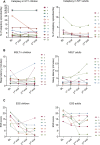Reviewing the Clinical Implications of Treating Narcolepsy as an Autoimmune Disorder
- PMID: 34007229
- PMCID: PMC8123964
- DOI: 10.2147/NSS.S275931
Reviewing the Clinical Implications of Treating Narcolepsy as an Autoimmune Disorder
Abstract
Narcolepsy type 1 (NT1) is a lifelong sleep disorder, primarily characterized clinically by excessive daytime sleepiness and cataplexy and pathologically by the loss of hypocretinergic neurons in the lateral hypothalamus. Despite being a rare disorder, the NT1-related burden for patients and society is relevant due to the early onset and chronic nature of this condition. Although the etiology of narcolepsy is still unknown, mounting evidence supports a central role of autoimmunity. To date, no cure is available for this disorder and current treatment is symptomatic. Based on the hypothesis of the autoimmune etiology of this disease, immunotherapy could possibly represent a valid therapeutic option. However, contrasting and limited results have been provided so far. This review discusses the evidence supporting the use of immunotherapy in narcolepsy, the outcomes obtained so far, current issues and future directions.
Keywords: immunomodulation; immunotherapy; intravenous immunoglobulin; monoclonal antibodies; narcolepsy type 1; steroid.
© 2021 Giannoccaro et al.
Conflict of interest statement
Maria Pia Giannoccaro and Fabio Pizza reports no conflicts of interest in this work. Rocco Liguori reports personal fees from Argenx, Biogen, Sanofi-Genzyme, Argon Healthcare s.r.l., Amicus Therapeutics s.r.l. and Alfasigma for Advisory Board consultancy and Lecture fees from Dynamicom Education, SIMG Service, Adnkronos Salute Unipersonale s.r.l. and DOC Congress s.r.l., outside the submitted work. Giuseppe Plazzi participated in advisory board for UCB Pharma, Idorsia, Jazz pharmaceuticals and Bioprojet.
Figures

Similar articles
-
Immunotherapy in Narcolepsy.Curr Treat Options Neurol. 2020 Jan 30;22(1):2. doi: 10.1007/s11940-020-0609-7. Curr Treat Options Neurol. 2020. PMID: 31997035 Review.
-
Connecting the dots: An updated review of the role of autoimmunity in narcolepsy and emerging immunotherapeutic approaches.Sleep Med. 2024 Jan;113:378-396. doi: 10.1016/j.sleep.2023.12.005. Epub 2023 Dec 16. Sleep Med. 2024. PMID: 38128432 Review.
-
Narcolepsy Type 1 as an Autoimmune Disorder: Evidence, and Implications for Pharmacological Treatment.CNS Drugs. 2017 Oct;31(10):821-834. doi: 10.1007/s40263-017-0464-6. CNS Drugs. 2017. PMID: 28940143 Review.
-
Management of Narcolepsy.Curr Treat Options Neurol. 2016 Oct;18(10):43. doi: 10.1007/s11940-016-0429-y. Curr Treat Options Neurol. 2016. PMID: 27549768 Review.
-
Narcolepsy during Childhood: An Update.Neuropediatrics. 2015 Jun;46(3):181-98. doi: 10.1055/s-0035-1550152. Epub 2015 May 11. Neuropediatrics. 2015. PMID: 25961600 Review.
Cited by
-
LC-MS/MS-Based Proteomics Approach for the Identification of Candidate Serum Biomarkers in Patients with Narcolepsy Type 1.Biomolecules. 2023 Feb 23;13(3):420. doi: 10.3390/biom13030420. Biomolecules. 2023. PMID: 36979356 Free PMC article.
-
Characterization of rapid weight gain phenotype in children with narcolepsy.CNS Neurosci Ther. 2022 Jun;28(6):829-841. doi: 10.1111/cns.13811. Epub 2022 Feb 25. CNS Neurosci Ther. 2022. PMID: 35212159 Free PMC article.
-
Higher basophil count decreases narcolepsy risk: a Mendelian randomization study.Neurol Sci. 2022 Sep;43(9):5575-5580. doi: 10.1007/s10072-022-06123-7. Epub 2022 May 12. Neurol Sci. 2022. PMID: 35554757
-
Serum N-Glycan Profiling of Patients with Narcolepsy Type 1 Using LC-MS/MS.ACS Omega. 2024 Jul 16;9(30):32628-32638. doi: 10.1021/acsomega.4c01593. eCollection 2024 Jul 30. ACS Omega. 2024. PMID: 39100283 Free PMC article.
-
LC-MS/MS Quantitation of HILIC-Enriched N-glycopeptides Derived from Low-Abundance Serum Glycoproteins in Patients with Narcolepsy Type 1.Biomolecules. 2023 Oct 28;13(11):1589. doi: 10.3390/biom13111589. Biomolecules. 2023. PMID: 38002271 Free PMC article.
References
-
- Medicine AA of S. The International Classification of Sleep Disorders, Third Edition (ICSD-3); 2014. (Medicine AA of S, editor.)
Publication types
LinkOut - more resources
Full Text Sources
Other Literature Sources

